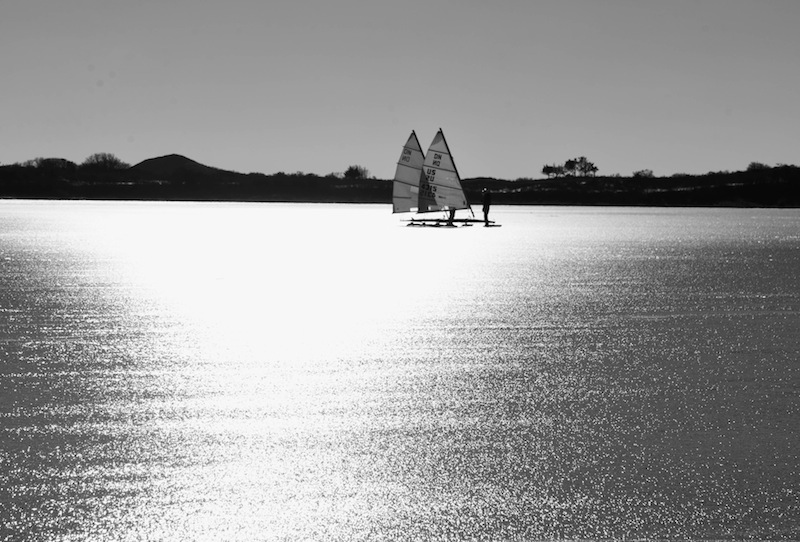A 16-foot sail is last thing you might expect to see on an Island pond in the depths of a freezing February. Across the Vineyard, boats have been hauled out of the water, waiting for spring. Ice has taken over.
But when the ponds freeze, a different kind of boat comes out of garages and sheds, having waiting months and sometimes years to make its appearance. It’s ice boating season.
The sport is a mishmash of bobsledding — witness how the boaters launch their vessels, pushing the lightweight crafts across the ice before leaping into a tiny cockpit — and sailing.
“There’s a runner [blade] in the front that you control with a tiller . . . and then the mast in the middle and the sail off that,” said Chris Carroll of Chilmark. “Other than a few wires, that’s really it.”
Mr. Carroll first tried ice boating in 2005 on the Edgartown Great Pond. He was hooked, but hadn’t had a chance to go out since then. The ice has to be just right.
Charlie Blair, best known as the Edgartown harbor master, has raced just about every type of sailboat and was a professional motorcycle racer for a time. But he said last week that there is nothing to compare with ice boating.
“It’s just great,” he said. “The speeds feel three times what they actually are, so you think you’re going 100 when you’re really going 35, 40. You’re lying on your back about three inches off the ice . . . the racing is just — it’s super dangerous and it’s super fast.”
Mr. Blair was hooked on the sport from his first test run. He and a friend had gone in together to buy a used ice boat from a Plymouth man for $750, a decision made on a whim while out goose hunting one winter morning. The ice that day certainly seemed thick enough to put on a boat on, so Mr. Blair’s friend started looking around for just the right vessel.
When the boat came to the Vineyard for its initial sail, it drew a crowd, including Scott McDowell of Chilmark.
“Scott came and he took a ride in the boat — half the Island came that day,” Mr. Blair said. “He went about 100 feet and wrecked it.” Then Mr. McDowell started to walk away, off the ice. Where are you going, Mr. Blair called.
“I’m going to get one,” came the reply.
In 1989, Mr. Blair and Mr. McDowell traveled to the world ice boating championships in Burlington, Vt. Boaters came from the Soviet Union and Poland, Finland and Sweden, Michigan and Maine.
“I think there were 400 ice boats there,” Mr. Blair said. “And we did quite poorly.”
But they continued to race in the championships, ultimately attending 17 more. It was easier to travel to Finland than to Michigan, Mr. Blair recalled — a drive to New York city and then an international flight. When he stepped down from international competition in 2001, he had 32 Helsinki stamps in his passport. He and Mr. McDowell became members of the International Ice Yacht Racing Association. They also built boats for competition. Mr. Blair still has one of his boats in Finland; he donated it to the country’s youth ice boating program.
“It’s a disease,” Mr. Blair said of the sport. “Every weekend we were driving to Michigan or driving somewhere. The racing was — down and dirty, really serious racing, but afterwards it was really serious partying.”
Most of their practices took place off-Island, though. The men used a phone hotline to find out where the best ice was, and then headed in that direction with their boats.
“There’s always ice somewhere in New England,” Mr. Blair said. But ice on the Vineyard, he said, is a fleeting thing.
And that makes the current conditions all the more of a gift, particularly for those who are just getting started with the sport.
“It’s really hard to get it where it’s really nice and smooth,” Mr. Carroll said. Black ice, he said, is “nearly transparent.” It is clear and solid, a strong ice that can support the weight of a boat and a man. When snow falls on the ice and gets packed down, as it did earlier this month, it’s called gray ice. Though it’s technically possible to ice boat on two inches of ice, a minimum of four inches is preferable. And while a helmet is the bare minimum for safety gear, everyone brings along a pair of spikes, Mr. Carroll said. “So if you do go in the water, you can kind of claw your way out.”
“When the ice finally formed up and was safe enough, I called a few people and said hey, let’s do this,” Mr. Carroll said. “We had a good five or six people going, we did pretty well.” The group first headed to Job’s Neck Pond before tackling Squibnocket. Squibby, which is about a mile long, is perfect for building up to racing speed.
“You need a bit of a breeze,” Mr. Carroll said. “At 15 it’s a lot of fun, and one guy told me at 20 miles an hour things start to break.” Boaters bundle up against the wind chill — in a photo Mr. Carroll took two weekends ago, everyone is wearing fleece-lined Carhartts and big mittens.
Though he didn’t go out this winter, Mr. Blair still has his fleet of ice boats and loaned some of his gear out to others. A couple of younger sailors, just learning to use Optimist sailboats, dropped by but didn’t take to the ice; they didn’t have enough overall experience yet, Mr. Blair said. He hopes they’ll get into the sport later, though.
Because next year, if the ice comes back, the boaters will too.






Comments (3)
Comments
Comment policy »